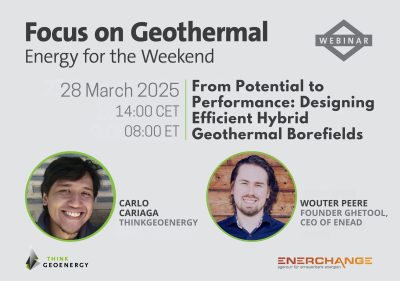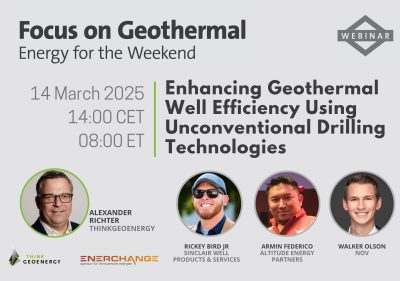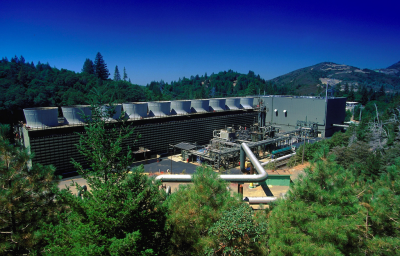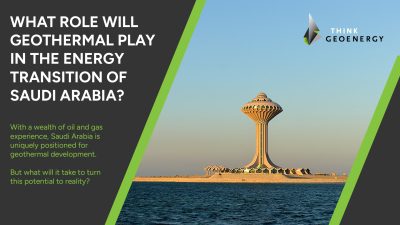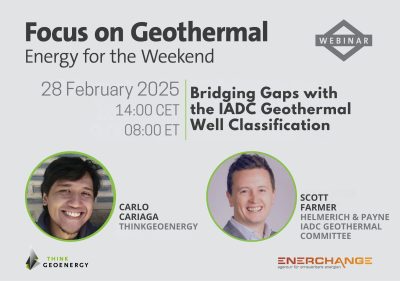GreenFire Energy – A scalable and flexible model for geothermal growth
In this interview, Rob Klenner tells us about GreenFire Energy's transition to full-spectrum geothermal development and focus on behind-the-meter projects.
One thing that often escapes mainstream discussion of geothermal is the fact that there are already several technological solutions that work. In many places around the world, technology is not the bottleneck for geothermal deployment. Rather, it is the lack of a policy environment and business model that allow geothermal projects to be commercially viable.
Under the leadership of new President Rob Klenner, GreenFire Energy is shifting its focus from being a technology developer and provider to being a vertically-integrated geothermal project developer. What will be GreenFire Energy’s unique approach to addressing the commercial challenges of geothermal, and what is its strategy for scaling up a geothermal power portfolio in the coming years?
In this interview, Klenner discusses the changes in GreenFire Energy, the behind-the-meter business model, and his thoughts on the state of government support for geothermal in the United States.
An evolving business model
For many years, the identity of GreenFire Energy had been closely tied to its proprietary GreenLoop closed-loop technology. The value proposition of the technology was sufficiently intriguing, seeking to generate geothermal energy from unproductive wells or in challenging geologies where traditional hydrothermal systems were not feasible.
However, GreenFire Energy is shifting focus under President Rob Klenner. Technology will still be a core competency, but the company now aspires to be a full-spectrum geothermal project developer matching technology to the geology for each project. GreenFire has already set an interim goal of building a 150-MW geothermal power portfolio by 2030.
Aside from Klenner, GreenFire Energy has also had some leadership growth with the appointment of Derek Dixon as Vice President of Business Development, and Cory Draper as Vice President of Asset Management. The team brings decades of expertise in energy systems, commercial strategy, and project execution.
Both necessity and opportunity have driven this evolution. To enable geothermal growth, it has to provide dependable and clean baseload energy to both private sector stakeholders and government clients. This means offering bespoke technological solutions that are compatible with the needs of the clients and the unique geology of each site. Rather than continue solely as a technology vendor, GreenFire Energy is stepping into the developer role – identifying viable sites, selecting the right tools for the subsurface, building projects, and delivering power directly to clients.
The vertically integrated approach also positions the company to participate more fully in their projects, with more control over timelines, project outcomes, and client relationships.
The strategic shift does not mean that GreenFire Energy will be abandoning its technological roots. Rather, their patented AGS solution will remain one of the options that GreenFire Energy can offer their customers, particularly in projects where it presents a distinct advantage. GreenFire Energy is now expanding their business with more geothermal solutions that are flexible and site-specific.
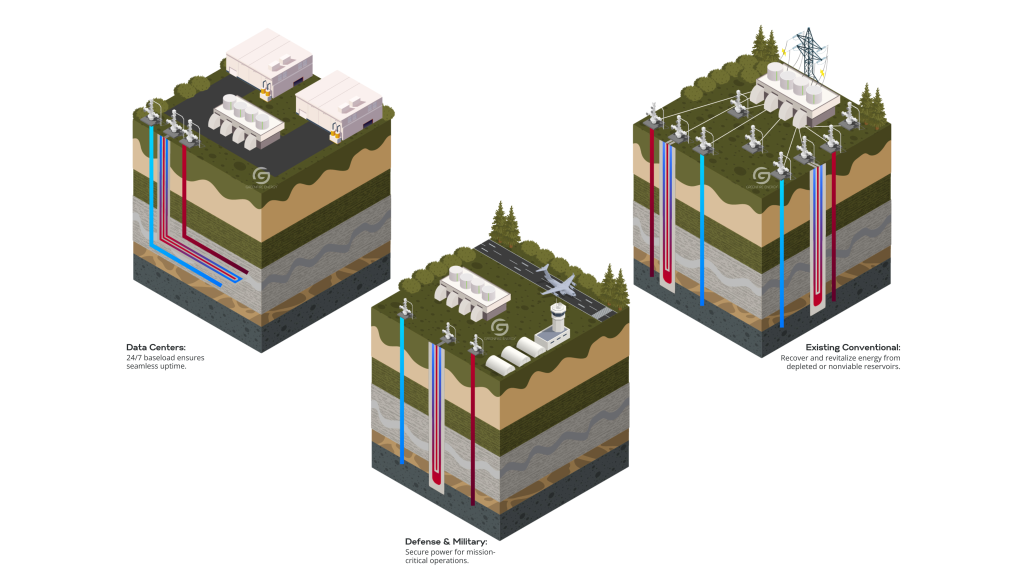
Matching technology to geology
A key aspect of GreenFire Energy’s new business model is its focus on flexibility. Rather than championing a single technology, GreenFire Energy believes that geology should dictate the optimal solution for geothermal utilization. “You don’t just drill a horizontal well everywhere because that’s your specialty,” Klenner explained. “You match the technology to the geology.”
In the geothermal context, this could mean deploying enhanced geothermal systems (EGS) or advanced geothermal systems (AGS) in impermeable formations, or revitalizing conventional resources with downhole heat exchangers. GreenFire Energy has already had hands-on experience with multiple geothermal methodologies, implementing closed-loop concepts at projects in the United States.
This technology-agnostic approach allows GreenFire Energy to be more responsive to project needs, resource constraints, and client expectations. This kind of adaptability is crucial in geothermal, where subsurface parameters may vary widely from one site to the next. As Klenner noted, future projects may even incorporate multiple technologies within a single development, perhaps mixing closed-loop systems with enhanced geothermal systems (EGS) where appropriate.
Realigning to a Behind-the-Meter (BTM) model
Recently, GreenFire Energy was announced as one of about a dozen companies that have been granted “awardable” status by the US Department of Energy for geothermal projects. This positions the company to work with the US Air Force, Navy, and Army to develop geothermal solutions for their branches and facilities worldwide.
The engagement with the US DoD is an excellent example of GreenFire Energy’s pivot toward behind-the-meter (BTM), co-located geothermal development. This approach focuses on deploying geothermal power systems directly at or near the sites where the electricity is consumed, such as data centers, military installations, and industrial facilities. The result is a highly localized, modular energy solution that offers several key advantages over traditional utility-scale developments.
The BTM model enables the faster deployment of geothermal power projects by removing the dependence on a distribution grid, which often require regulatory and infrastructure considerations. GreenFire Energy is also open to developing smaller scale power projects when necessary. “We want to be agile and modular,” said Klenner. “We’re focusing on 5- to 25-MW projects that can be deployed quickly and scaled as needed.”
The strategy of phased development also provides the added benefit of reducing early-stage risk and capital intensity. This provides a more accessible pathway to geothermal project development while still maintaining the flexibility to scale up given the right conditions.
In addition to the DoD, GreenFire Energy is pursuing projects with data centers, food processing plants, and even remote communities. Klenner notes that clients are less interested in the technology used for geothermal, but more on the reliability, cost, and emissions reduction that tapping into this energy source can bring. “They just want green electrons,” Klenner says succinctly.
A 150-MW portfolio by 2030
GreenFire Energy has set an ambitious target of developing 150 MW of installed geothermal capacity by 2030. Rather than banking on a few mega-projects, the company is cultivating a geographically and technologically diverse portfolio. A significant portion of this future portfolio is expected to come from projects with the US DoD. GreenFire Energy is also exploring the concept of integrated energy parks, where geothermal is co-located with solar, wind, nuclear, or gas to create robust, multi-source power hubs.
This phased development strategy allows GreenFire Energy to build experience, de-risk technologies, and generate early revenue—all while laying the foundation for larger-scale deployments. “We want our first 5 MW, then our next 10, and then our next 20,” said Klenner. “It’s about building momentum while being smart with resources.”
The company is also investing in early-stage exploration in areas with high geothermal gradients across the western U.S. These exploratory efforts aim to create a pipeline of future projects that can move quickly once permitting and technical assessments are complete.
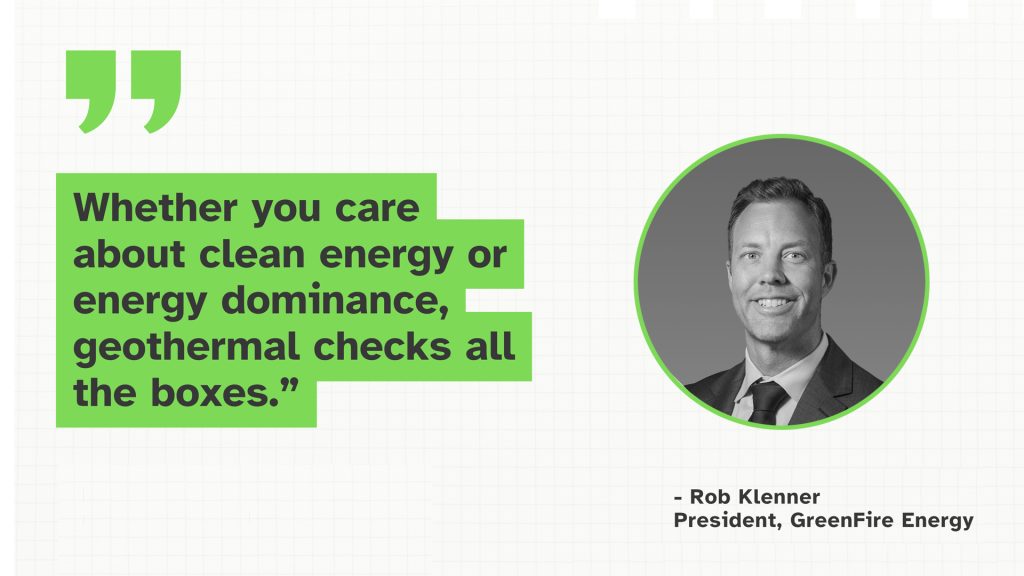
Strengthening support for geothermal in the US
The geothermal industry in the United States has steadily grown momentum in the last few years. Based on recent pronouncements from the Trump administration and Energy Secretary Chris Wright, geothermal appears well-positioned to continue to receive strong policy support. “I think there is a tailwind here with the new administration, and it’s good news for geothermal,” Klenner commented.
For GreenFire Energy, the vocal support for geothermal is a welcome development that aligns perfectly with the company’s expanding vision. Klenner remains optimistic about both the current administration’s support and the broader bipartisan consensus around geothermal as a critical pillar of energy security. “Geothermal is bipartisan,” said Klenner. “Whether you care about clean energy or energy dominance, it checks all the boxes.”
However, Klenner also believes more needs to be done to elevate geothermal to the level of other emerging technologies like hydrogen and carbon capture. “The hydrogen hubs got $6 billion. If we got $6 billion for geothermal, we could build projects across the country,” he said. Programs like the DOE’s Geothermal Technologies Office (GTO) and initiatives such as FORGE have laid important groundwork, but larger, more coordinated funding efforts are needed to fully commercialize next-generation geothermal.
The company remains active in global markets, including Kenya, Indonesia, and the Philippines, where it provides engineering services and supports local developers. These partnerships are critical to extending in international regions the technologies developed and tested in the US. Klenner sees this as a major growth opportunity in the future. “We’re building megawatts here, but we’re still supporting projects overseas. When the time is right, we’ll develop internationally, too.”
By putting customer needs first, GreenFire Energy aims to leverage technical versatility and partnerships to deploy geothermal projects faster. Setting new goals and business models, the company has had to evolve significantly over the last few months. This is par for the course for the geothermal industry, which has been more dynamic than ever in recent years. As Klenner put it: “Things are always changing. GreenFire Energy has expanded our leadership team, refined our direction, and focused our strategy on domestic projects. If you don’t change, then you can’t move forward as quickly.”












